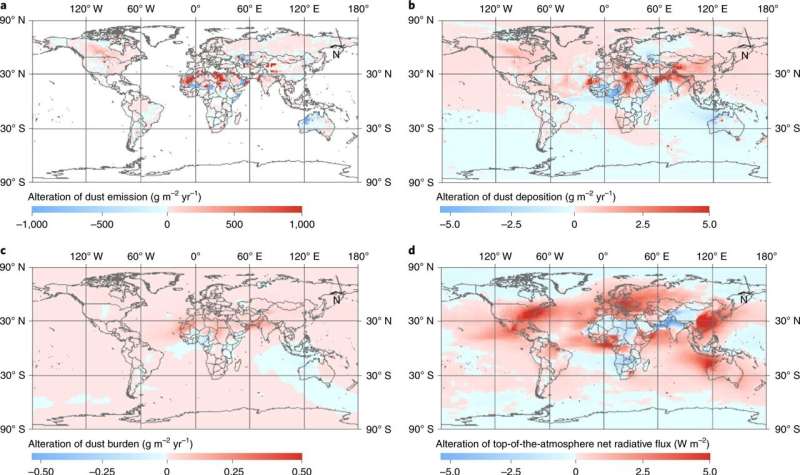May 17, 2022 report
Modeling suggests loss of biocrusts by 2070 could result in increase of 15% more dust emissions

An international team of researchers has found via global modeling that loss of biocrusts due to global warming could result in an additional 15% more dust emitted into the atmosphere by 2070. In their paper published in the journal Nature Geoscience, the group describes their analysis of currently available data regarding the impact of biocrust on global cycling and what impact losses of biocrusts could mean as the planet continues to warm.
Biological soil crusts (biocrusts) are land areas that are dry but not sandy. Instead, the top layer of soil contains a community of nonvascular plants, microbes and lichens. Together, they harden and prevent the soil from being blown into the atmosphere. The researchers suggest they are comparable to living skin, covering as much as 12% of all land surfaces worldwide. They note that despite the important role biocrusts play in the atmospheric dust cycle, little about them is known. In this new effort, the researchers sought to learn more about the role biocrusts play and what might happen to them and the dust cycle as the planet continues to grow warmer. To that end, they collected data from the limited amount of work conducted on biocrusts and combined it with global climate models.
The researchers found that biocrusts currently prevent approximately 700 teragrams of dust from being emitted into the atmosphere every year, which they further suggest is approximately 55% less than would be the case were there no biocrusts. The climate model showed that global warming is on track to reduce biocrusts to the point that global dust emissions will increase by 15% by 2070. Currently, it is not known what impact an increase in dust emissions might have on the planet as a whole, or which places might see the greatest impacts. Prior research has shown that dust in the atmosphere scatters solar radiation and also plays a major role in ice and cloud formation. Dust particles have also been found to carry nutrients long distances, and in some cases, have even been found to carry bacteria and viruses.
More information: E. Rodriguez-Caballero et al, Global cycling and climate effects of aeolian dust controlled by biological soil crusts, Nature Geoscience (2022). DOI: 10.1038/s41561-022-00942-1
Journal information: Nature Geoscience
© 2022 Science X Network




















